Time on the Wrist
by Bob Brooke
QUESTION:
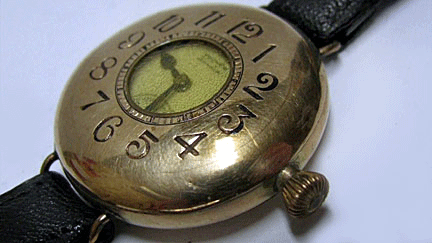 I
have an unusual wristwatch that belonged to my great grandfather.
According to my father, he wore it while a soldier in World War I.
Evidently, it was a special military watch that soldiers used to
calculate the distance of mortar fire. What can you tell me about
the history of this watch? I
have an unusual wristwatch that belonged to my great grandfather.
According to my father, he wore it while a soldier in World War I.
Evidently, it was a special military watch that soldiers used to
calculate the distance of mortar fire. What can you tell me about
the history of this watch?
Thanks,
Harold
_________________________________________________________
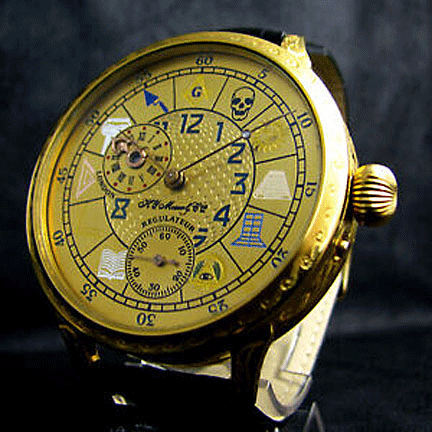 ANSWER:
You, indeed,
have a special watch. Wearing a wristwatch for men actually began after
World War I. And it was because of the military the wristwatch is as we
know it today. ANSWER:
You, indeed,
have a special watch. Wearing a wristwatch for men actually began after
World War I. And it was because of the military the wristwatch is as we
know it today.
The word "watch" came from the Old English word woecce, meaning
"watchman" because town watchmen used them to keep track of their shifts
at work.
But it was military officers who first wore wristwatches. One
chronograph had a scale calibrated to tell the difference in time
between the flash of field artillery and the sound of the report. This
helped a soldier know how far away the guns were.
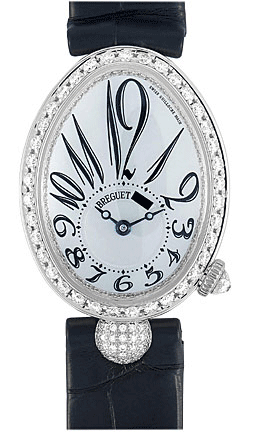 However,
wristwatches as they look today first appeared in the 1890s. Evolving
from pocket watches, makers specifically developed them for women. And
because of this, men didn’t wear them, continuing to use pocket watches
instead. However,
wristwatches as they look today first appeared in the 1890s. Evolving
from pocket watches, makers specifically developed them for women. And
because of this, men didn’t wear them, continuing to use pocket watches
instead.
Some historians believe that Abraham-Louis Breguet created the world's
first wristwatch for Caroline Murat, Queen of Naples, in 1810. And by
the 1850s, most watchmakers produced a variety of wristwatches,
marketing most of them as bracelets for women.
So when and how did men begin to wear wristwatches?
Military men first began to wear wristwatches towards the end of the
19th century, when the importance of synchronizing maneuvers during war
without potentially revealing the plan to the enemy through signaling
became important. It was clear that using pocket watches while in the
heat of battle or while mounted on a horse wasn’t practical, so officers
began to strap the watches to their wrist.
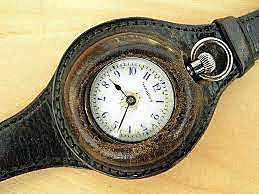 The
Garstin Company of London patented a 'Watch Wristlet' design in 1893,
although they had been producing similar designs from the 1880s.
Garstin’s owners realized a market for men's wristwatches was opening
up. Officers in the British Army began using wristwatches during
colonial military campaigns in the 1880s, such as during the Anglo-Burma
War of 1885. The
Garstin Company of London patented a 'Watch Wristlet' design in 1893,
although they had been producing similar designs from the 1880s.
Garstin’s owners realized a market for men's wristwatches was opening
up. Officers in the British Army began using wristwatches during
colonial military campaigns in the 1880s, such as during the Anglo-Burma
War of 1885.
During the Boer War, the importance of coordinating troop movements and
synchronizing attacks against the highly mobile Boer insurgents
increased. Subsequently, British officers began using wristwatches. The
company Mappin & Webb began production of their successful “campaign
watch” for soldiers during the campaign at the Sudan in 1898 and ramped
up production for the Boer War a few years later.
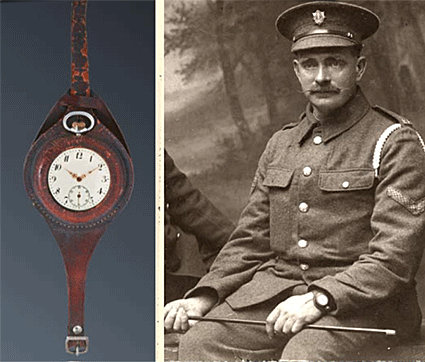
These early models were essentially standard pocket watches fitted to a
leather strap, but by the first decade of the 20th century,
manufacturers began producing purpose-built wristwatches. The Swiss
company, Dimier Frères & Cie patented a wristwatch design with the now
standard wire strap lugs in 1903.
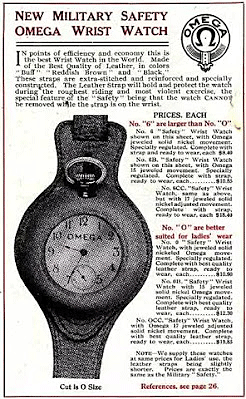 Omega
advertisements mentioned that soldiers used its wristwatches in the
Anglo-Boer War not only to highlight their excellent quality but also to
break through the wristwatches-are-for-women barrier. Omega
advertisements mentioned that soldiers used its wristwatches in the
Anglo-Boer War not only to highlight their excellent quality but also to
break through the wristwatches-are-for-women barrier.
When World War I broke out in 1914, air warfare was in its infant
stages, thus creating a heightened need for military watches. Military
fighter pilots also found wristwatches to be as needed in the air as on
the ground. With the increased sophistication of battle techniques,
wristwatches for fighter pilots and ground soldiers became essential
items. At that time, Hamilton first supplied its flagship military watch
Khaki to the American army.
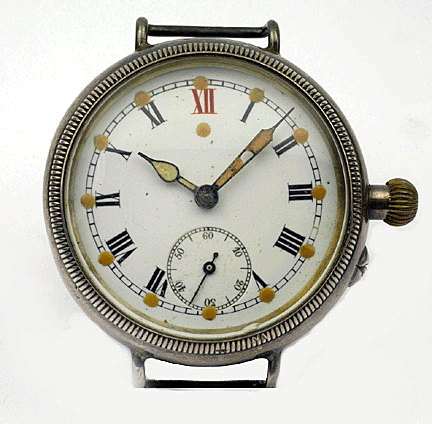 In
the chaos of the trenches during the heat of battle, it was impossible
for soldiers to rifle through their pockets for a watch. European
soldiers began outfitting their watches with unbreakable glass to
survive the trenches and radium to illuminate the display at night.
Civilians saw the wristwatch’s practical benefits over the pocket watch
and began wearing them. In
the chaos of the trenches during the heat of battle, it was impossible
for soldiers to rifle through their pockets for a watch. European
soldiers began outfitting their watches with unbreakable glass to
survive the trenches and radium to illuminate the display at night.
Civilians saw the wristwatch’s practical benefits over the pocket watch
and began wearing them.
World War I dramatically shifted public perceptions on the propriety of
the man's wristwatch and opened up a mass market in the post-war era.
The creeping barrage artillery tactic, developed during the War,
required precise synchronization between the artillery gunners and the
infantry advancing behind the barrage. Manufacturers produced service
watches specially designed for the rigors of trench warfare, with
luminous dials and unbreakable glass. The British War Department began
issuing wristwatches to combatants from 1917.
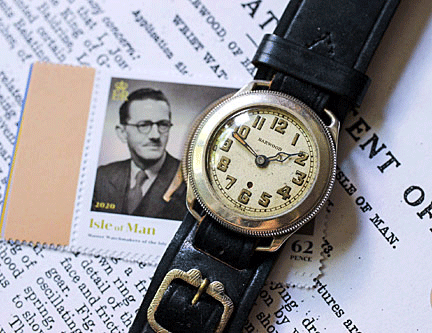
By the end of World War I, almost all enlisted men wore a wristwatch.
After the War, the fashion of men wearing wristwatches soon caught on.
In 1923, John Harwood invented the first successful automatic winding
system. And by 1930, the ratio of wrist- to pocket watches was 50 to 1.
Wristwatch ads boasted wristwatches “for men with the promise that a
watch could make a man more soldierlike, more martial, more masculine.”
<
Back to Readers Ask Archives
Next Article >
|
